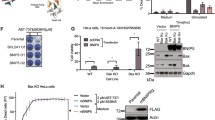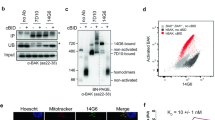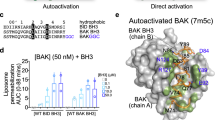Abstract
The pro-apoptotic protein Bak is converted from a latent to an active form by damage-induced signals. This process involves an early exposure of an occluded N-terminal epitope of Bak in intact cells. Here we report a subsequent damage-induced change in Bak, detected using an antibody to the central BH-1 domain. Bak co-immunoprecipitated with Bc1-xL both in undamaged cells and early after damage, when the N-terminal epitope was exposed but the BH-1 epitope remained occluded. A subsequent decrease in binding of Bak to Bc1-xL correlated with exposure of an epitope in the Bak BH-1 domain. Overexpression of Bc1-xL did not affect the kinetics of exposure of the Bak N-terminal epitope but delayed exposure of the BH-1 domain. Cytochrome c release from mitochondria facilitates the activation of apoptotic caspases. The majority of cells with exposed Bak BH-1 domains contained cytosolic cytochrome c. However, a small proportion of cells exhibited exposed Bak BH-1 domains that co-localized with mitochondrial cytochrome c. The data are consistent with a two-step model for the activation of Bak by drug-induced damage signals where dissociation of Bc1-xL from the BH-1 domain of Bak occurs immediately prior to or concomitantly with cytochrome c release.
This is a preview of subscription content, access via your institution
Access options
Subscribe to this journal
Receive 50 print issues and online access
$259.00 per year
only $5.18 per issue
Buy this article
- Purchase on SpringerLink
- Instant access to full article PDF
Prices may be subject to local taxes which are calculated during checkout






Similar content being viewed by others
References
Adams JM, Cory S . 1988 Science 281: 1322–1326
Cheng EH-Y, Kirsch DG, Clem RJ, Ravi R, Kastan MB, Bedi A, Veno K, Hardwick JM . 1997 Science 278: 1966–1968
Clem RJ, Cheng EH, Carp CL, Kirsch DG, Ueno K, Takahashi A, Kastan MB, Griffin DE, Earnshaw WC, Veliuona MA, Hardwick JM . 1998 Proc. Natl. Acad. Sci. USA 95: 554–559
Datta SR, Dudek H, Tao X, Masters S, Fu H, Gotoh Y, Greenberg ME . 1997 Cell 91: 231–241
Desagher S, Osen A, Nichols A, Eskes R, Montessuit S, Lauper S, Maundrell K, Antonsson B, Martinou JC . 1999 J. Cell. Biol. 144: 891–901
Deng X, Xiao L, Lang W, Gaof, Ruvolo P, May Jr WS . 2001 J. Biol. Chem., 276: 23681–23688
Eskes R, Desagher S, Antonsson B, Martinou J-C . 2000 Mol. Cell. Biol. 20: 929–935
Fisher DE . 1994 Cell 78: 539–542
Gilmore AP, Metcalfe AD, Romer LH, Streuli CH . 2000 J. Cell. Biol. 149: 431–445
Goldstein JC, Waterhouse NJ, Juin P, Evan GI, Green DR . 2000 Nat. Cell Biol. 2: 156–162
Green DR, Reed JC . 1998 Science 28: 1309–1312
Griffiths GJ, Dubrez L, Morgan CP, Jones NA, Whitehouse J, Corfe BM, Dive C, Hickman JA . 1999 J. Cell Biol. 144: 903–914
Gross A, Yin XM, Wang K, Wei MC, Jockel J, Milliman C, Erdjument-bromage H, Tempsi P, Korsmeyer SJ . 1999 J. Biol. Chem. 274: 1156–1163
Hsu YT, Wolter KG, Youle RJ . 1997 Proc. Natl. Acad. Sci. USA 94: 3668–3672
Hsu YT, Youle RJ . 1997 J. Biol. Chem. 272: 13829–13834
Kluck RM, Bossy Wetzel E, Green DR, Newmeyer DD . 1997 Science 275: 1132–1136
Knudson CM, Korsmeyer SJ . 1997 Nat. Genet. 16: 358–363
McDonnell JM, Fushman D, Milliman CL, Korsmeyer SJ, Cowburn D . 1999 Cell 96: 625–634
Miyashita T, Reed JC . 1995 Cell 80: 293–299
Muchmore SW, Sattler M, Liang H, Meadows RP, Harlan JW, Yoon HS, Mettesheim D, Chang BS, Wong SL, Ng A, Fesik SW . 1996 Nature 381: 335–341
Murphy KM, Streips UN, Lock RB . 2000 J. Biol. Chem. 275: 17225–17228
Oltvai Z, Korsmeyer SJ . 1994 Cell 79: 189–192
Sattler MH, Liang D, Nettesheim RP, Meadows JE, Harlan M, Eberstadt M, Yoon H-S, Shuker SB, Chang BS, Minn AJ, Thompson CB, Fesik SW . 1997 Science, 275: 983–986
Schendel SL, Xie Z, Mantal MO, Matsuyama S, Mootal M, Reed JC . 1997 Proc. Natl. Acad. Sci. USA 94: 5113–5118
Suzuki M, Youle RJ, Tjandra N . 2000 Cell 103: 645–654
Taylor ST, Hickman JA, Dive C . 2000 J. Natl. Cancer. Inst. 92: 18–23
Wang KA, Gross G, Waksman G, Korsmeyer SJ . 1998 Mol. Cell. Biol. 18: 6083–6089
Wei CM, Lindsten T, Mootha VK, Weiler S, Gross A, Ashiya M, Thompson CB, Korsmeyer SJ . 2000 Genes Dev. 14: 2060–2071
Wolter KG, Hsu YT, Smith CL, Nechushtan A, Xi XG, Youle RJ . 1997 J. Cell Biol. 139: 1281–1292
Yin X-M, Oltvai ZN, Korsmeyer SJ . 1998 Nature 369: 321–323
Acknowledgements
Caroline Dive was supported by the Lister Institute of Preventive Medicine, Mauro Degli Esposti is supported by Institut de Recherches Servier, Paris. We thank: Katja Dohendorf and Maïlys Vergnolle for technical assistance; Sabina Cosulich for gifts of plasmids; Guy Makin and Charles Streuli for their critical appraisal of the manuscript and Daniela Riccardi for her advice regarding the confocal microscopy. The work was funded by the Cancer Research Campaign, The Biotechnology and Biological Sciences Research Council and The Wellcome Trust.
Author information
Authors and Affiliations
Corresponding author
Rights and permissions
About this article
Cite this article
Griffiths, G., Corfe, B., Savory, P. et al. Cellular damage signals promote sequential changes at the N-terminus and BH-1 domain of the pro-apoptotic protein Bak. Oncogene 20, 7668–7676 (2001). https://doi.org/10.1038/sj.onc.1204995
Received:
Revised:
Accepted:
Published:
Issue date:
DOI: https://doi.org/10.1038/sj.onc.1204995
Keywords
This article is cited by
-
Mitochondrial E3 ubiquitin ligase MARCHF5 controls BAK apoptotic activity independently of BH3-only proteins
Cell Death & Differentiation (2023)
-
Characterization of an alternative BAK-binding site for BH3 peptides
Nature Communications (2020)
-
A small molecule interacts with VDAC2 to block mouse BAK-driven apoptosis
Nature Chemical Biology (2019)
-
Is cytotoxicity a determinant of the different in vitro and in vivo effects of bioactives?
BMC Complementary and Alternative Medicine (2017)
-
Bak apoptotic pores involve a flexible C-terminal region and juxtaposition of the C-terminal transmembrane domains
Cell Death & Differentiation (2015)



